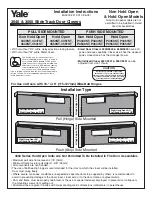
OperatiOn
HPR400XD Auto Gas –
806160
4-27
thick stainless steel piercing technique
overview
Hypertherm has developed a technique for extending the stainless steel piercing capability of the HPR400XD and
HPR800XD systems:
•
The HPR400XD can now perform a moving pierce on stainless steel workpieces 75 mm (3 inches) thick.
•
The HPR800XD can now perform a moving pierce on stainless steel workpieces 100 mm (4 inches) thick.
The moving pierce technique (sometimes referred to as a “flying pierce” or “running pierce”) enables operators to cut
through thick plates using their plasma systems, without having to resort to other methods such as drilling. It starts torch
motion immediately after transfer and during the pierce process.
While the parameters for this moving pierce process are built into Hypertherm’s CNC software and nesting software,
the information is available to all HPRXD customers and can be used with other compatible CNCs and nesting software
programs.
How moving pierce works
The moving pierce method uses a
combination of torch height control, table
motion, and plasma current adjustments
to form a path in the plate through which
the molten metal can flow safely away from
the torch. This is accomplished through
a series of defined segment lengths
and speeds that are synchronized with
torch lifter motion. In this way, the molten
material can be kept as far from the torch
as possible while also maintaining a
sustainable arc voltage.
Operators should plan the direction of the
moving pierce in their part geometry so that
this “rooster tail” of molten metal and hot
gases does not get directed at themselves
or at the gantry, torch lifter, controller, other
torches, or other sensitive equipment. As
the molten metal is fed to the side of the
torch in the opposite direction of the table
motion, most of it gets deposited on top
of the plate. Once the arc penetrates the
plate, operators can use the standard settings for cutting.
Note:
Different material chemistries can have an adverse effect on the pierce capability of the system. The moving
pierce settings detailed in this document were developed using 304L stainless steel.
For details on the sequencing involved in coordinating the torch height and table motion in order to perform this type
of moving pierce, refer to the
Moving Pierce Technique
white paper (part number 807840), which can be found in the
“Downloads library” on the Hypertherm website at www.hypertherm.com. There you can also find a
Thick Metal Cutting
Techniques
white paper (part number 807850), which contains technical details on other techniques for cutting thick
metal, including the dogleg lead-out technique, that Hypertherm offers as enhancements to its HPRXD systems.
Evacuation path for
molten metal
Molten metal pushed
back to top of plate
Summary of Contents for HyPerformance HPR400XD
Page 1: ...HyPerformance Plasma HPR400XD Auto gas Instruction manual 806160 Revision 4 ...
Page 26: ...Specifications 2 2 HPR400XD Auto Gas 806160 ...
Page 48: ...Installation 3 10 HPR400XD Auto Gas 806160 ...
Page 53: ...Installation HPR400XD Auto Gas 806160 3 15 Horizontal RHF mounting Vertical RHF mounting ...
Page 57: ...Installation HPR400XD Auto Gas 806160 3 19 This page is blank intentionally ...
Page 65: ...Installation HPR400XD Auto Gas 806160 3 27 7 8 8 7 ...
Page 100: ...Installation 3 62 HPR400XD Auto Gas 806160 ...
Page 107: ...Operation HPR400XD Auto Gas 806160 4 7 Diagnostic screen ...
Page 108: ...Operation 4 8 HPR400XD Auto Gas 806160 Test screen ...
Page 109: ...Operation HPR400XD Auto Gas 806160 4 9 Cut chart screen ...
Page 197: ...Operation HPR400XD Auto Gas 806160 4 97 ...
Page 287: ...7 4 HPR400XD Auto Gas 806160 Discrete output functionality ...
Page 347: ...Appendix B CNC Interface Protocol b 28 HPR400XD Auto Gas 806160 ...
Page 355: ...4 HPR400XD Auto Gas 806160 ...
















































